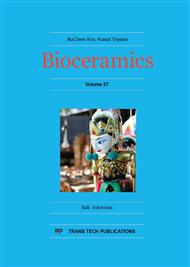[1]
J. B. Park and R. S. Lakes, Biomaterials: An Introduction, 3rd Ed., Springer Science, New York, (2007).
Google Scholar
[2]
M.J. Jarcho, J.L. Kay, R.H. Gumaer and H.P. Drobeck, Tissue, cellular and subcellular events at bone-ceramic hydroxyapatite interface, J. Bioeng. 1 (1977) 79-92.
Google Scholar
[3]
R.Z. LeGeros, J.P. LeGeros, Dense hydroxyapatite, in: L. L. Hench, J. Wilson, (Eds), An Introduction to Bioceramics, World Scientific, Singapore, 1993, pp.139-180.
DOI: 10.1142/9789814317351_0009
Google Scholar
[4]
R.Z. LeGeros, J.P. LeGeros, Hydroxyapatite, in: T. Kokubo, (Ed), Bioceramics and their clinical applications, Woodhead Publishing, Cambridge, 2008, pp.367-394.
DOI: 10.1533/9781845694227.2.367
Google Scholar
[5]
H. Oonishi, H. Oonishi Jr and S.C. Kim, Clinical application of hydroxyapatite, in: T. Kokubo, (Ed), Bioceramics and their clinical applications, Woodhead Publishing, Cambridge, 2008, pp.606-687.
DOI: 10.1533/9781845694227.3.606
Google Scholar
[6]
D.D. Deligianni, N.D. Katsala, P.G. Koutsoukos and Y.F. Missirlis, Effect of surface roughness of hydroxyapatite on human bone marrow cell adhesion, proliferation, differentiation and detachment strength, Biomaterials. 22 (2001) 87-96.
DOI: 10.1016/s0142-9612(00)00174-5
Google Scholar
[7]
S.C. Rizzi, D.J. Heath, A.G.A. Coombes, N. Bock, M. Textor and S. Downes, Biodegradable polymer/hydroxyapatite composites: surface analysis and initial attachment of human osteoblasts, J. Biomed. Mater. Res. 55 (2001) 475-486.
DOI: 10.1002/1097-4636(20010615)55:4<475::aid-jbm1039>3.0.co;2-q
Google Scholar
[8]
A. Tiselius, S. Hjerten and O. Levin, Protein chromatography on calcium phosphate columns Arch. Biochem. Biophys. 65 (1956) 132-155.
DOI: 10.1016/0003-9861(56)90183-7
Google Scholar
[9]
T. Kokubo, H. Kushitani, S. Sakka, T. Kitsugi, T. Yamamuro, Solutions able to reproduce in vivo surface-structure changes in bioactive glass-ceramic A-W, J. Biomed. Mater. Res. 24 (1990) 721-734.
DOI: 10.1002/jbm.820240607
Google Scholar
[10]
T. Kokubo, H. Takadama, How useful is SBF in predicting in vivo bone bioactivity?, Biomaterials 27 (2006) 2907-2915.
DOI: 10.1016/j.biomaterials.2006.01.017
Google Scholar
[11]
ISO/FDIS 23317, Implants for surgery — In vitro evaluation for apatite-forming ability of implant materials, International Organization for Standardization (2007).
Google Scholar
[12]
H. Takadama, T. Kokubo, In vitro evaluation of bone bioactivity, in: T. Kokubo (Ed. ), Bioceramics and their clinical applications, Woodhead Publishing, Cambridge, 2008, pp.165-182.
DOI: 10.1533/9781845694227.1.165
Google Scholar
[13]
T. Yao, M. Hibino, S. Yamaguchi and H. Okada, U.S. Patent 8, 178, 066 (2012), Japan Patent 5, 261, 712 (2013).
Google Scholar
[14]
S. Kumazawa, D. Hisashuku, T. Yabutsuka, T. Yao, Fabrication of magnetic hydroxyapatite microcapsule for protein collection, Key Eng. Mater. 587 (2014) 160-164.
DOI: 10.4028/www.scientific.net/kem.587.160
Google Scholar
[15]
T. Miyazaki, Preparation of biocompatible ceramic nanotubes, New Technology Presentation Meetings, Japan Science and Technology Agency (2011).
Google Scholar


